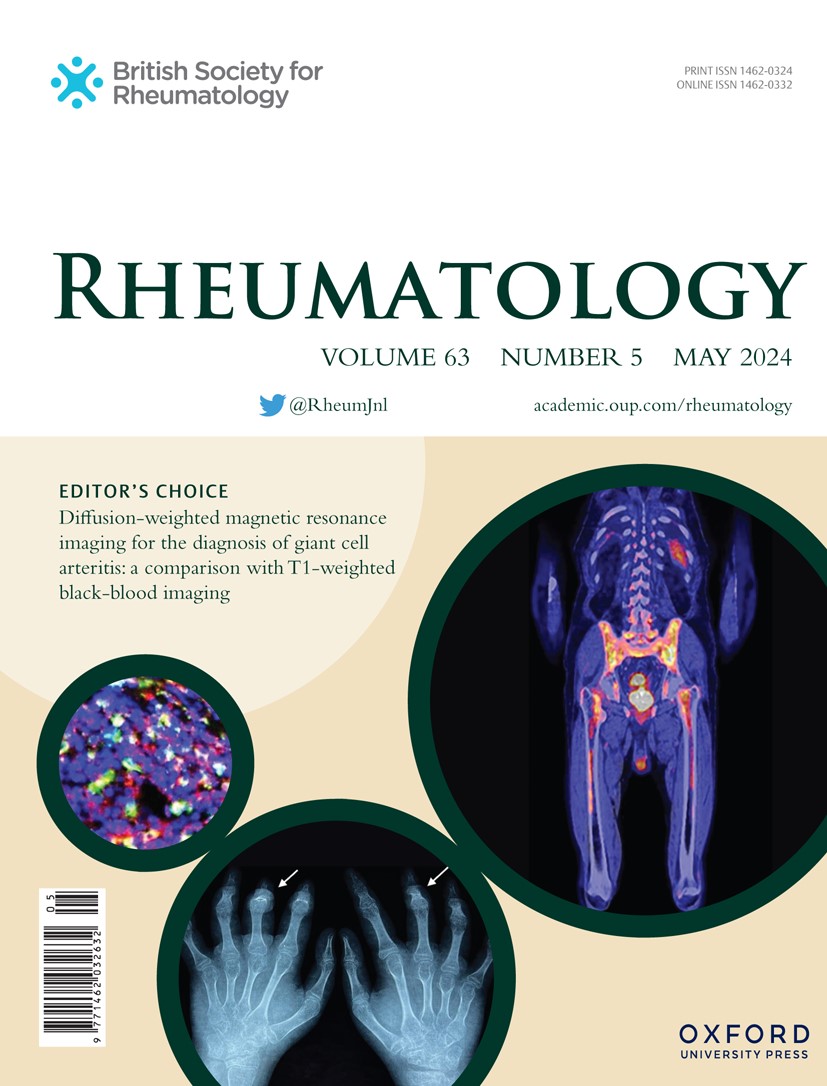Gastrointestinal involvement in very early and established systemic sclerosis: insights from the SPRING-SIR national Italian registry.
IF 4.4
2区 医学
Q1 RHEUMATOLOGY
引用次数: 0
Abstract
OBJECTIVES To describe the prevalence of gastrointestinal (GI) symptoms in systemic sclerosis (SSc) and Very Early Diagnosis of SSc (VEDOSS), identify clinical and serological features associated with GI involvement, and explore a cranio-caudal pattern of symptom distribution, using data from the Italian SPRING-SIR registry. METHODS This cross-sectional analysis included patients fulfilling 2013 ACR/EULAR SSc or VEDOSS criteria. GI involvement was defined as symptoms in at least one GI tract segment and categorized as upper and lower. Associations between GI involvement and clinical variables were assessed using logistic and ordinal regression models, adjusting for demographics, disease characteristics, and autoantibodies. RESULTS Among 1917 SSc patients, 56% had GI symptoms, associated with longer disease duration, diffuse cutaneous SSc (dcSSc), interstitial lung disease (ILD), digital ulcers (DU), telangiectasias, and tobacco exposure. Extensive GI involvement correlated with more severe disease. Ordinal regression identified female sex, dcSSc, ILD, DU, telangiectasias, tobacco exposure, and anti-centromere antibodies as variables significantly associated with more extensive GI involvement. Disease duration did not show a significant association with GI symptom extent. Among 211 VEDOSS patients, 41.2% reported GI symptoms (mostly esophageal), significantly associated with puffy fingers, and dyspnea. Among VEDOSS, puffy fingers and anti-centromere antibodies were independent predictors of presence of esophageal symptoms. CONCLUSION GI involvement in SSc is linked to more severe disease and longer disease duration. Disease duration resulted linked to the presence of GI symptoms rather than extent of GI involvement. Puffy fingers and anti-centromere antibodies may associate with presence of early esophageal symptoms in VEDOSS.胃肠介入非常早期和建立系统性硬化症:来自SPRING-SIR意大利国家登记处的见解。
目的:描述系统性硬化症(SSc)中胃肠道(GI)症状的患病率和SSc的早期诊断(VEDOSS),确定与胃肠道受累相关的临床和血清学特征,并利用意大利SPRING-SIR登记的数据探索症状分布的颅尾模式。方法本横断面分析纳入符合2013年ACR/EULAR SSc或VEDOSS标准的患者。胃肠道受累定义为至少一个胃肠道段出现症状,并分为上消化道和下消化道。使用logistic和有序回归模型评估GI受累与临床变量之间的关系,并根据人口统计学、疾病特征和自身抗体进行调整。结果在1917例SSc患者中,56%有胃肠道症状,与病程延长、弥漫性皮肤SSc (dcSSc)、间质性肺疾病(ILD)、指端溃疡(DU)、毛细血管扩张和烟草暴露相关。广泛的胃肠道受累与更严重的疾病相关。有序回归发现,女性、dcSSc、ILD、DU、毛细血管扩张、烟草暴露和抗着丝粒抗体是与更广泛的胃肠道病变显著相关的变量。病程与胃肠道症状程度无显著相关性。在211例VEDOSS患者中,41.2%的患者报告了胃肠道症状(主要是食管),与肿胀的手指和呼吸困难显著相关。在VEDOSS中,肿胀的手指和抗着丝粒抗体是存在食管症状的独立预测因子。结论i参与SSc与更严重的疾病和更长的疾病持续时间有关。疾病持续时间与胃肠道症状的出现有关,而与胃肠道受累程度无关。肿胀的手指和抗着丝粒抗体可能与VEDOSS患者早期食管症状的存在有关。
本文章由计算机程序翻译,如有差异,请以英文原文为准。
求助全文
约1分钟内获得全文
求助全文
来源期刊

Rheumatology
医学-风湿病学
CiteScore
9.40
自引率
7.30%
发文量
1091
审稿时长
2 months
期刊介绍:
Rheumatology strives to support research and discovery by publishing the highest quality original scientific papers with a focus on basic, clinical and translational research. The journal’s subject areas cover a wide range of paediatric and adult rheumatological conditions from an international perspective. It is an official journal of the British Society for Rheumatology, published by Oxford University Press.
Rheumatology publishes original articles, reviews, editorials, guidelines, concise reports, meta-analyses, original case reports, clinical vignettes, letters and matters arising from published material. The journal takes pride in serving the global rheumatology community, with a focus on high societal impact in the form of podcasts, videos and extended social media presence, and utilizing metrics such as Altmetric. Keep up to date by following the journal on Twitter @RheumJnl.
 求助内容:
求助内容: 应助结果提醒方式:
应助结果提醒方式:


